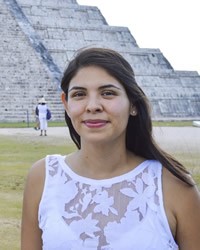Mexican in Canada

Photo Source:
Darvin Santos - Pixabay
|
Send Joshua Project a map of this people group.
|
| People Name: | Mexican |
| Country: | Canada |
| 10/40 Window: | No |
| Population: | 49,000 |
| World Population: | 106,568,000 |
| Primary Language: | Spanish |
| Primary Religion: | Christianity |
| Christian Adherents: | 92.00 % |
| Evangelicals: | 8.00 % |
| Scripture: | Complete Bible |
| Ministry Resources: | Yes |
| Jesus Film: | Yes |
| Audio Recordings: | Yes |
| People Cluster: | Hispanic |
| Affinity Bloc: | Latin-Caribbean Americans |
| Progress Level: |
|
Introduction / History
The history of the Mexican people is what makes them an amazing mosaic developed from diverse cultures that include Amerindian, Mestizo (Mixed Spanish, African, and indigenous Indian ethnicity), and European (primarily Spanish) cultures. Although archaeological evidence has shown that ancient settlements date back several thousand years in Mexico, its major civilizations were located mainly in central and southern Mexico. These included the Olmecs, the Mayans, and the Aztecs. Each of these worshipped multiple gods whose powers were associated with nature, including animals and reptiles. Their lives revolved around their gods. Human sacrifice was one of the offerings given to the gods, especially among the Mayan and Aztecs. The agrarian Olmecs lasted from about 1400 to 400 BC.
From about 300 BC, the Maya-speaking people came into power and ruled until about 800 AD. Eventually, their kingdom stretched from the Pacific coasts of southern Mexico and Guatemala to the northern Yucatán Peninsula. Their wealthy elite constructed massive ceremonial temples, pyramids, and complex city dwellings. Around 400 BC, the Maya adopted the idea of a monarchy. Their city of Teotihuacan was built between 100 BC and 250 AD. It was their economic and religious center and one of the largest cities in the world at this time, with an estimated population between 150,000 and 200,000.
In 1100 AD, the Aztecs, also known as the Mexica, a Nahuatl-speaking people, began their migration south from their homeland of Aztlan in northern Mexico. They fought with the Mayans and other local tribes. In 1325, they started building their famous city of Tenochtitlan (modern Mexico City). According to legend, the location originated when the Aztecs observed the foretold sign of an eagle eating a snake while standing on a cactus (Aloe). Tenochtitlan, translated, means "Place of the stone prickly pear cactus abundance." This image remains on the current Mexican flag.
In 1427, the Aztec King Tzcoatl officially founded the Aztec Empire. King Montezuma I ruled between 1440 to 1469 and greatly expanded the empire. He was followed by Montezuma II in 1502.
The Spanish conquistador Hernán Cortés and his men arrived on the shores of Mexico in pursuit of gold for Spain in 1519. At first, the Aztecs believed Cortez was a god; however, the deception was soon exposed. Through treachery and raw power, the Spanish Empire defeated and subdued the Aztecs.
The Spanish used indigenous people as serfs as they moved north and south, expanding Spain's holdings. Black slaves, an estimated 200,000, were brought to Mexico. They were used as foremen by the Spanish. Spanish men married indigenous women. Their children were what we now call mestizos.
Spanish Catholicism was enforced to destroy the Aztecs' beliefs in their gods. In 1529, the Franciscan friar Bernardino Sahagún traveled to Mexico as a missionary priest. He learned the Nahuatl language and spent over 50 years studying Aztec beliefs, culture, and history. He translated important Bible texts like the Psalms and the Gospels into Nahuatl. His famous book, General History of the Things of New Spain, included over 2,500 pictures drawn by native artists describing the Aztec culture. His books were written in Spanish and Nahuatl. His amazing work earned him the title "the first anthropologist. It opened the doors of understanding the Aztecs for many missionaries and others.
By 1680, 94% of the Aztec population had died primarily due to disease (smallpox brought by the Spanish), malnutrition, and extreme hard labor.
For 300 years, Spain ruled the land until the early 1800s, when the Mexicans revolted against the Spanish. They finally gained independence in 1821.
There is a large Mexican diaspora in the United States and Canada.
What Are Their Lives Like?
Mexicans in Canada can work in the business sector or study, but most are farm workers.
A small number of people work for the Mexican embassy in Ottawa. Mexican restaurants are popular. There are Mexicans who are professional athletes and entertainers in Canada.
What Are Their Beliefs?
The Mexican people usually identify as Catholic. However, a large majority are involved in Spirit and cult worship, witchcraft. Many people look to spiritual healers, who, in turn, seek input from dark spirits. The Death Cult of Santa Muerte, or Skeleton Saint, is the fastest-growing cult in Mexico with several million followers. This cult can trace its foundation back to Mictecacihuatl, an Aztec goddess who presided over a festival of death every August.
Another growing cult is Santeria. It combines West Africa's Yoruba spirituality, Caribbean traditional spiritualism, and elements of Catholicism. The spirit priests in these cults use various methods to communicate with the spirits, such as trances, divination, ritual practices, drugs, and some forms of animal sacrifice. Many Mexican people believe it is ok to draw from many religious traditions if they feel these will help them with a practical need. Many have never read the Bible.
What Are Their Needs?
Mexican people have many needs. The major ones are spiritual confusion, governmental corruption, drug trafficking, and the hope that their socioeconomic disparity will change.
Prayer Points
Pray that the Mexican people will look only to the God of the Bible for strength and protection.
Pray for them to overcome economic, educational, and medical challenges.
Pray for the Holy Spirit to move powerfully in their churches, drawing millions into the loving arms of Christ.